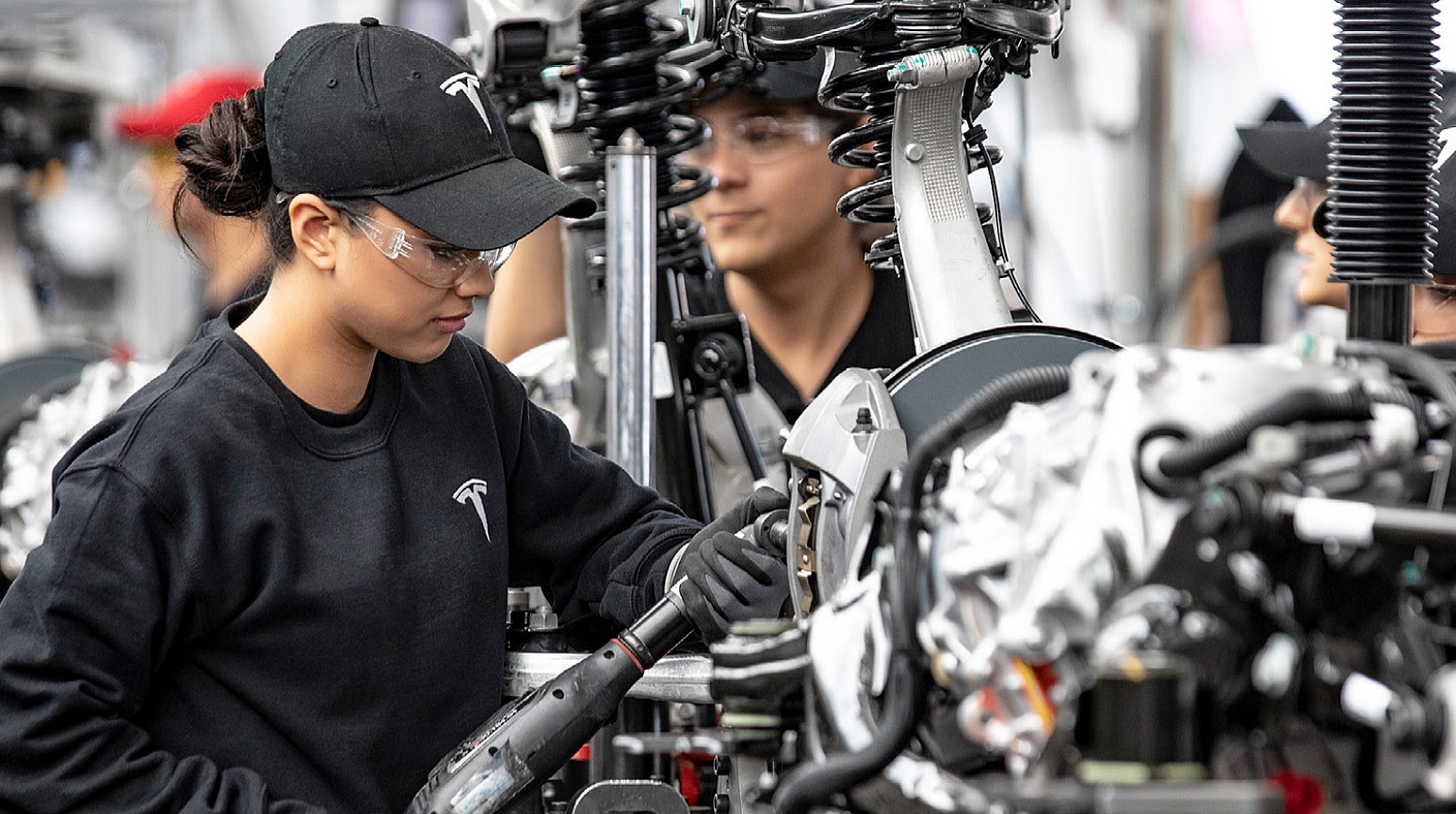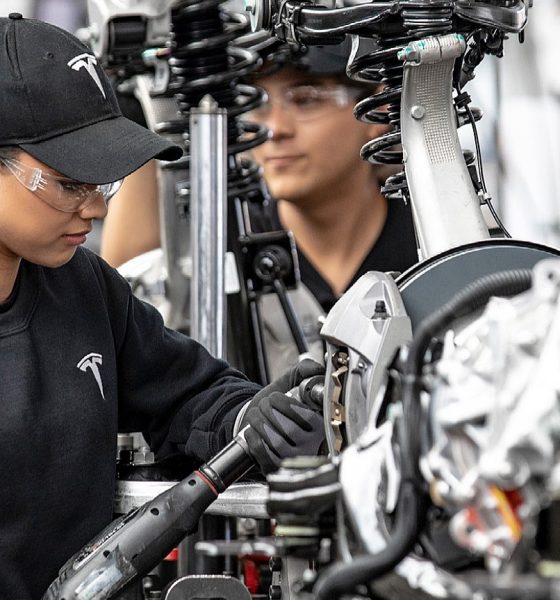Tesla’s employee headcount grew by 23 percent in 2022, while other tech companies eliminated positions due to economic conditions.
In 2022, layoffs hit the tech sector hard, as companies like Google, Twitter, Facebook/Meta, and others eliminated employees to save money with the threat of a recession looming.
Tesla was one of those companies, but its headcount was reduced by removing unnecessary full-time corporate positions and some remote workers. Many media outlets reported that Tesla would slash its employee headcount by as much as 10 percent, but the automaker had plans to increase its hourly employees in manufacturing.
CEO Elon Musk said in an email to employees last year that 10 percent of salaried positions would be eliminated “as we have become overstaffed in many areas.”
Musk added that the reduction “does not apply to anyone building cars, battery packs, or installing solar. Hourly headcount will increase.” However, some employees were let go due to the cuts, leaving Tesla in hot water.
Elon Musk says Tesla will reduce salaried headcount by 10%, while increasing hourly employees
Tesla shed more detail on its employee headcount in 2022 through its 10-K filed with the SEC, which was released this morning.
The automaker finished 2022 with a full-time headcount of 127,855 employees globally, an increase of 28,565 employees:
“As of December 31, 2022, our full-time count for our and our subsidiaries’ employees worldwide was 127,855, a 29,000 year-over-year increase.”
At the end of 2021, Tesla said it had 99,290 employees, up from 70,757 in 2020.
Tesla has routinely increased its number of employees to keep up with its growing impact on the automotive and energy sectors.
Manufacturing is arguably the most important piece of Tesla’s daily tasks, and the company is constantly hiring new employees to keep up with increased vehicle production rates.
After delivering 1.3 million vehicles last year, Tesla has its sights set on figures of at least 1.8 million in 2023, with Musk recently indicating that potential volume is near 2 million cars. It is imperative that Tesla continue to ramp manufacturing to reach these goals, and more employees will need to contribute to the effort as production ramps at facilities like Gigafactory Texas.
Tesla’s largest employers are its Gigafactory facilities, and Gigafactory Texas could be the largest contributor to headcount growth over the coming years. The factory is still in the process of expanding, and Musk has hinted that as many as 20,000 people could eventually work at the Austin plant.
I’d love to hear from you! If you have any comments, concerns, or questions, please email me at joey@teslarati.com. You can also reach me on Twitter @KlenderJoey, or if you have news tips, you can email us at tips@teslarati.com.

Elon Musk
Elon Musk confirms xAI’s purchase of five 380 MW natural gas turbines
The deal, which was confirmed by Musk on X, highlights xAI’s effort to aggressively scale its operations.

xAI, Elon Musk’s artificial intelligence startup, has purchased five additional 380 MW natural gas turbines from South Korea’s Doosan Enerbility to power its growing supercomputer clusters.
The deal, which was confirmed by Musk on X, highlights xAI’s effort to aggressively scale its operations.
xAI’s turbine deal details
News of xAI’s new turbines was shared on social media platform X, with user @SemiAnalysis_ stating that the turbines were produced by South Korea’s Doosan Enerbility. As noted in an Asian Business Daily report, Doosan Enerbility announced last October that it signed a contract to supply two 380 MW gas turbines for a major U.S. tech company. Doosan later noted in December that it secured an order for three more 380 MW gas turbines.
As per the X user, the gas turbines would power an additional 600,000+ GB200 NVL72 equivalent size cluster. This should make xAI’s facilities among the largest in the world. In a reply, Elon Musk confirmed that xAI did purchase the turbines. “True,” Musk wrote in a post on X.
xAI’s ambitions
Recent reports have indicated that xAI closed an upsized $20 billion Series E funding round, exceeding the initial $15 billion target to fuel rapid infrastructure scaling and AI product development. The funding, as per the AI startup, “will accelerate our world-leading infrastructure buildout, enable the rapid development and deployment of transformative AI products.”
The company also teased the rollout of its upcoming frontier AI model. “Looking ahead, Grok 5 is currently in training, and we are focused on launching innovative new consumer and enterprise products that harness the power of Grok, Colossus, and 𝕏 to transform how we live, work, and play,” xAI wrote in a post on its website.
Elon Musk
Elon Musk’s xAI closes upsized $20B Series E funding round
xAI announced the investment round in a post on its official website.

xAI has closed an upsized $20 billion Series E funding round, exceeding the initial $15 billion target to fuel rapid infrastructure scaling and AI product development.
xAI announced the investment round in a post on its official website.
A $20 billion Series E round
As noted by the artificial intelligence startup in its post, the Series E funding round attracted a diverse group of investors, including Valor Equity Partners, Stepstone Group, Fidelity Management & Research Company, Qatar Investment Authority, MGX, and Baron Capital Group, among others.
Strategic partners NVIDIA and Cisco Investments also continued support for building the world’s largest GPU clusters.
As xAI stated, “This financing will accelerate our world-leading infrastructure buildout, enable the rapid development and deployment of transformative AI products reaching billions of users, and fuel groundbreaking research advancing xAI’s core mission: Understanding the Universe.”
xAI’s core mission
Th Series E funding builds on xAI’s previous rounds, powering Grok advancements and massive compute expansions like the Memphis supercluster. The upsized demand reflects growing recognition of xAI’s potential in frontier AI.
xAI also highlighted several of its breakthroughs in 2025, from the buildout of Colossus I and II, which ended with over 1 million H100 GPU equivalents, and the rollout of the Grok 4 Series, Grok Voice, and Grok Imagine, among others. The company also confirmed that work is already underway to train the flagship large language model’s next iteration, Grok 5.
“Looking ahead, Grok 5 is currently in training, and we are focused on launching innovative new consumer and enterprise products that harness the power of Grok, Colossus, and 𝕏 to transform how we live, work, and play,” xAI wrote.
Investor's Corner
Tesla gets price target bump, citing growing lead in self-driving

Tesla (NASDAQ: TSLA) stock received a price target update from Pierre Ferragu of Wall Street firm New Street Research, citing the company’s growing lead in self-driving and autonomy.
On Tuesday, Ferragu bumped his price target from $520 to $600, stating that the consensus from the Consumer Electronics Show in Las Vegas was that Tesla’s lead in autonomy has been sustained, is growing, and sits at a multiple-year lead over its competitors.
CES 2026 validates Tesla’s FSD strategy, but there’s a big lag for rivals: analyst
“The signal from Vegas is loud and clear,” the analyst writes. “The industry isn’t catching up to Tesla; it is actively validating Tesla’s strategy…just with a 12-year lag.”
The note shows that the company’s prowess in vehicle autonomy is being solidified by lagging competitors that claim to have the best method. The only problem is that Tesla’s Vision-based approach, which it adopted back in 2022 with the Model 3 and Model Y initially, has been proven to be more effective than competitors’ approach, which utilizes other technology, such as LiDAR and sensors.
Currently, Tesla shares are sitting at around $433, as the company’s stock price closed at $432.96 on Tuesday afternoon.
Ferragu’s consensus on Tesla shares echoes that of other Wall Street analysts who are bullish on the company’s stock and position within the AI, autonomy, and robotics sector.
Dan Ives of Wedbush wrote in a note in mid-December that he anticipates Tesla having a massive 2026, and could reach a $3 trillion valuation this year, especially with the “AI chapter” taking hold of the narrative at the company.
Ives also said that the big step in the right direction for Tesla will be initiating production of the Cybercab, as well as expanding on the Robotaxi program through the next 12 months:
“…as full-scale volume production begins with the autonomous and robotics roadmap…The company has started to test the all-important Cybercab in Austin over the past few weeks, which is an incremental step towards launching in 2026 with important volume production of Cybercabs starting in April/May, which remains the golden goose in unlocking TSLA’s AI valuation.”
Tesla analyst breaks down delivery report: ‘A step in the right direction’
Tesla has transitioned from an automaker to a full-fledged AI company, and its Robotaxi and Cybercab programs, fueled by the Full Self-Driving suite, are leading the charge moving forward. In 2026, there are major goals the company has outlined. The first is removing Safety Drivers from vehicles in Austin, Texas, one of the areas where it operates a ride-hailing service within the U.S.
Ultimately, Tesla will aim to launch a Level 5 autonomy suite to the public in the coming years.










